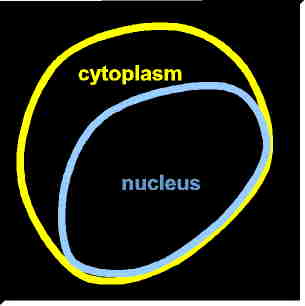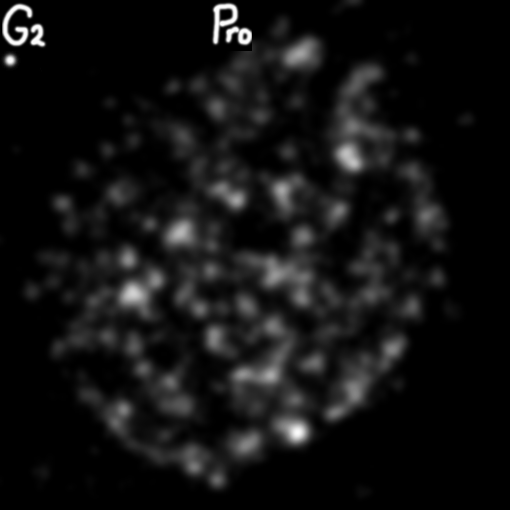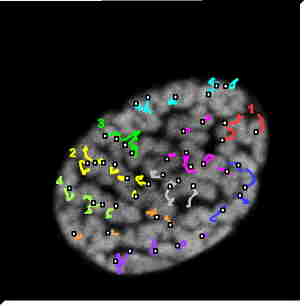Movie of condensing chromosomes
Individual frames from this movie form parts of Fig. 5 in Manders et al. [Manders, E.M.M., Kimura, H. and Cook, P.R. (1999). Direct imaging of DNA in living cells reveals the dynamics of chromosome formation. J. Cell Biol. 144, 813-822. [PubMed] [pdf]]
A fluorescent analogue (ie Cy5-dUTP) of the natural precursor - thymidine triphosphate - is introduced into cells, which are then grown on the heated stage of a confocal microscope; the analogue is incorporated by endogenous enzymes into DNA. As these enzymes are concentrated in discrete 'factories' and the analogue is quickly consumed, only parts of a chromosome become fluorescent. Surprisingly, the mechanisms for recognizing and removing the unusual residues do not prevent subsequent progress around the cell cycle, so the now-fluorescent DNA strands can be followed as they assemble into chromosomes. The movie follows an Indian muntjac cell which was allowed to incorporate Cy5-dUTP late during S phase; the movie begins in G2 phase, and ends once prophase chromosomes have formed. Immediately after the last frame was taken, the cell was fixed and stained with SYTO16 so that the chromosomes could be seen.
| Diagram of cell |  |
| Movie (white dot at top marks time between G2 phase and prophase) |  |
| Prophase chromosomes (seen after collecting the last frame, and then fixing and staining the cells) |  |
In the cytoplasm, label is concentrated in rapidly-moving foci (ie in vesicles and mitochondria); in the nucleus, label is found in late-replicating (heterochromatic) foci which move much more slowly. Many nuclear foci can be traced from interphase to their final position in a chromosome. Simplified tracks have been superimposed on the prophase image to illustrate these movements, with tracks of the same colour marking foci from the same chromosome. At the beginning of the movie, individual chromosomal segments seem to be elastically deformed by larger external forces (these may result indirectly from cellular movement). Surprisingly, foci also move very little as prophase chromosomes form (ie towards the end of the movie). Once formed, prophase chromosomes then go on to move rapidly during mitosis (not shown here), as observed classically.
![Transcription factories in a Hela cell [from Cook PR (1999) Science 284, 1790]](pombo.png)
